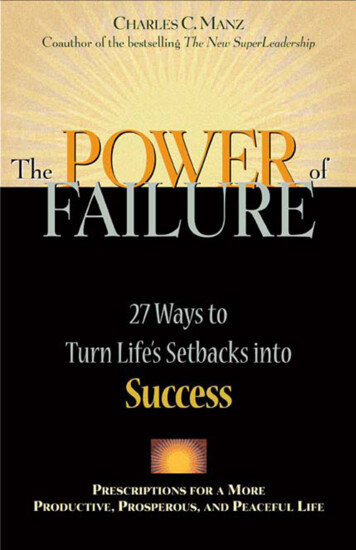
Transcription
10 Ways to Winthe Global Raceto Net-Zero:Global insights to inform Canadianclimate competitivenessIISD REPORTDan WoynillowiczEstan BeedellPeter Wooders 2021 International Institute for Sustainable Development IISD.orgMay 2021
10 Ways to Win the Global Race to Net-Zero:Global insights to inform Canadian climate competitiveness 2021 International Institute for Sustainable DevelopmentPublished by the International Institute for Sustainable DevelopmentThis publication is licensed under a Creative Commons AttributionNonCommercial-ShareAlike 4.0 International License.International Institute for Sustainable DevelopmentThe International Institute for Sustainable Development (IISD) is anaward-winning independent think tank working to accelerate solutions fora stable climate, sustainable resource management, and fair economies.Our work inspires better decisions and sparks meaningful action to helppeople and the planet thrive. We shine a light on what can be achievedwhen governments, businesses, non-profits, and communities cometogether. IISD’s staff of more than 120 people, plus over 150 associates andconsultants, come from across the globe and from many disciplines. Withoffices in Winnipeg, Geneva, Ottawa, and Toronto, our work affects lives innearly 100 countries.Head Office111 Lombard Avenue, Suite 325Winnipeg, ManitobaCanada R3B 0T4Tel: 1 (204) 958-7700Website: www.iisd.orgTwitter: @IISD newsIISD is a registered charitable organization in Canada and has 501(c)(3)status in the United States. IISD receives core operating support from theProvince of Manitoba and project funding from governments inside andoutside Canada, United Nations agencies, foundations, the private sector,and individuals.10 Ways to Win the Global Race to Net-Zero:Global insights to inform Canadian climate competitivenessMay 2021Written by Dan Woynillowicz, Estan Beedell, and Peter Wooders.AcknowledgementsThe authors gratefully acknowledge the financial support of the IveyFoundation that made this report possible. We would also like to thankRichard Florizone, Jane McDonald, Vanessa Corkal, and Joachim Roth fortheir input and review.IISD.orgii
10 Ways to Win the Global Race to Net-Zero:Global insights to inform Canadian climate competitivenessExecutive SummaryFrom loss of life to loss of livelihoods, the COVID-19 pandemic has exposed both ourvulnerability and our ability to overcome adversity through solidarity, cooperation, andingenuity—traits that will prove essential in combatting another global crisis: climate change.With each passing day, more countries—and, increasingly, more companies—pledge to limitglobal warming to 1.5 C by reaching net-zero greenhouse gas (GHG) emissions by 2050.Collectively, countries with net-zero targets represent 61% of global GHG emissions, 68% ofglobal GDP, and 52% of the global population. Companies with net-zero commitments togetherrepresent sales of nearly USD 14 trillion.Net-zero is the new normal. But how do we get there?A growing body of research, modelling, and analysis is beginning to paint a picture of howcountries can get to net-zero by mid-century. To better understand these possible pathways, wereviewed six reports focused on how different countries could get the job done. Across all thestudies, there are several findings that stand out.First, energy efficiency and electrification—substituting clean power for fossil fuels—have thecapacity to deliver the greatest contribution. Second, while most efforts to date have focused oncarbon dioxide (CO2) emissions, we must also reduce other greenhouse gas emissions, such asmethane and hydrofluorocarbons. And third, the decarbonization of heavy industry is challengingbut essential, and hydrogen could prove a key enabler of these reductions.Many of these actions are already being put into practice around the world, illustrating howgovernments and businesses are beginning to translate net-zero ambition into action, takingsteps to deliver the systemic change needed to succeed by mid-century. Sweden, for example,is punching above its weight in the race to produce green steel, and Germany has the poleposition in deploying a comprehensive strategy to ramp up production and use of hydrogen.The European Battery Alliance has launched a continental battery industry and is making rapidstrides toward battery self-sufficiency for its rapidly growing electric vehicle industry. In all threecases, governments articulated the objective, convened and collaborated with business leaders todevelop a roadmap, and provided significant resources to kickstart the journey.Getting to net-zero also requires changes in governance, as exemplified by President Biden’s“all-of-government” approach, which has included structural changes to enhance coordinationand collaboration across the numerous departments and government agencies whose mandatesimpact—or are impacted by—climate change. In New Zealand, the government is advancingreconciliation by elevating Māori voices as equal partners in climate action. And recognizingthat no region or person can be left behind in the energy transition, the European Union (EU) isforging new ground with its Just Transition Mechanism.IISD.orgiii
10 Ways to Win the Global Race to Net-Zero:Global insights to inform Canadian climate competitivenessWhile these examples of leading and innovative approaches to systemic transition can’t simply becopied and pasted into the Canadian context, we can draw some key insights to inform our ownmade-in-Canada solutions.Informed and inspired by efforts elsewhere, we offer five strategies to accelerate action towardnet-zero in Canada. First, we need to kickstart new industry consortia to work together andwith government on roadmaps to net-zero. Second, we need to build Indigenous leadershipinto Canada’s energy transition and climate action. Third, we need to organize and structurethe federal government for net-zero success. Fourth, we need to support a just transition forCanadian workers that keeps pace with the energy transition. And fifth, we need to ensure aprincipled, transparent approach to when and how we rely on carbon removals and offsets.On paper, “net-zero by 2050” appears feasible, but this ambitious goal demands wide-reaching,systemic transformation and cooperation across all sectors. If Canada is to achieve net-zeroemissions and prosper in the process, the pace of our efforts will need to accelerate, and there’s notime to lose.IISD.orgiv
10 Ways to Win the Global Race to Net-Zero:Global insights to inform Canadian climate competitivenessTable of Contents1.0 Net-Zero, New Normal. 12.0 Principles and Solutions for Net-Zero.83.0 Global Insights: Case studies.123.1 Driving Industrial Innovation: Green steel in Sweden. 123.2 A Holistic Approach to Hydrogen: Germany’s hydrogen strategy. 153.3 Advancing Electrification Through Collaboration: The European Battery Alliance. 193.4 Business & Civil Society Collaboration: The Energy Transition Commission.243.5 Net-Zero Necessitates an “All-of-Government” Approach: The Biden Administration.283.6 Advancing Reconciliation: Māori climate leadership. 313.7 Enabling a Just Transition: The EU approach. 324.0 Implications and Opportunities for Canada . 36Recommendations: 10 Ways to Win the Global Race to Net-Zero.36Five Key Solutions on the Path to Net-Zero.36Five Strategies to Kickstart Near-Term Action.37References. 39IISD.orgv
10 Ways to Win the Global Race to Net-Zero:Global insights to inform Canadian climate competitivenessList of FiguresFigure 1. Temperature difference 2020 and 1981–2010. 2Figure 2. Net-zero targets are gaining in popularity. 3Figure 3. Percentage of GHG emissions, GDP and population covered by national net-zeropledges (the status of these pledges ranges widely, including proposed, in discussion,in policy document, in law, and achieved). 3Figure 4. Global Energy Transition Investment, 2004–2020.4Figure 5. G20 government support for fossil fuels and clean energy during the COVID-19pandemic.6Figure 6. Canadian government support for fossil fuels and clean energy during the COVID-19pandemic.6Figure 7. Governance structure of the National Hydrogen Strategy. 18Figure 8. Overview of the European Battery Alliance. 20Figure 9. Collaboration between the EU and member states, the European Battery Alliance andR&I Networks. 23Figure 10. Energy Transition Commission strategic approach. 25Figure 11. Beneficiaries and support offered under the Just Transition Mechanism. 33Figure 12. Three pillars of the EU Just Transition Mechanism.34List of TablesTable 1. Fossil Fuel and Renewable Power 5-year Portfolio Returns up to December 31, 2020.5Table 2. Common Net-Zero Solutions in Country-Level Studies.10Table 3. Climate Roadmap: For a Fossil-Free and Competitive Steel Industry in Sweden. 13Table 4. Goals and ambitions of the German National Hydrogen Strategy. 17Table 5. European Battery Alliance Priority Actions.21Table 6. Country-level activities of the Energy Transition Commission. 26Table 7. Departments and Agencies comprising the National Climate Task Force.29IISD.orgvi
10 Ways to Win the Global Race to Net-Zero:Global insights to inform Canadian climate competitiveness1.0 Net-Zero, New NormalIn late 2018, the release of the Intergovernmental Panel on Climate Change’s (IPCC’s) specialreport on the impacts of global warming sent shockwaves around the world. Coming on the heelsof a decade that saw year after year of record-setting average temperatures and climate-fuelledforest fires, flooding, and drought, the report’s dire finding that the world could exceed 1.5 Cof global warming as early as 2030 was a wakeup call. In no uncertain terms, it made clear that“every bit of warming matters,” illustrating clear benefits to limiting warming to 1.5 C rather than2 C or higher (IPCC, 2018). But even more significantly—and optimistically—it concluded “thatlimiting warming to 1.5ºC is possible within the laws of chemistry and physics but would requireunprecedented transitions in all aspects of society” (IPCC, 2018).This lit a fire under political and businessleaders alike, and throughout 2019a growing number of countries andcompanies began to adopt the 2050 targetwhich, the IPCC report surmised, wouldoffer the prospect of limiting warming to1.5 C: net-zero greenhouse gas (GHG)emissions. Since then, “the phrase ‘netzero’ has gone from being a somewhatobscure scientific concept to centre stagein discourse on halting climate change”(Black et al., 2021).What is “net-zero”?A net-zero economy is one in which thesum of all greenhouse gases equals zero.After switching to non-pollutingtechnologies, any remaining emissionsare zeroed out by sucking carbon outof the atmosphere, whether throughnature-based or technology-basedremoval.Net-zero is the new normal.While it might have been expected that the COVID-19 pandemic would slow or even derailthis momentum for climate action, the opposite has occurred, and for a good reason. Last yearthe impacts of a changing climate continued to wreak havoc around the world—exemplifiedby record-breaking wildfires in Siberia, Australia, and California—and 2020 tied 2016 for thewarmest year on record (Figure 1).IISD.org1
10 Ways to Win the Global Race to Net-Zero:Global insights to inform Canadian climate competitivenessFigure 1. Temperature difference 2020 and 1981–2010Source: Copernicus Climate Change Service, n.d.A March 2021 analysis conducted by the University of Oxford and the Energy & ClimateIntelligence Unit surveyed more than 4,000 significant entities, including all nations, all states andregions in the 25 highest-emitting countries, all cities with a population above 500,000, and allcompanies in the Forbes Global 2000 list (Black et al., 2021). It found that 769 (19%) of theseentities have a net-zero target in place, including 124 nations (61% of the world’s total), 73 statesand regions, 155 cities, and 417 companies (Figure 2).IISD.org2
10 Ways to Win the Global Race to Net-Zero:Global insights to inform Canadian climate competitivenessFigure 2. Net-zero targets are gaining in popularity769(19%) of these entities havea net-zero target in place41715512473CompaniesCitiesNations(61% of the world)States &RegionsSource: Black et al., 2021Perhaps most significantly, the world’s three biggest emitters—China (by 2060), the UnitedStates, and the EU (both by 2050)—have all made net-zero commitments. India, the fourthlargest emitter, is reportedly considering adopting a net-zero target by mid-century, and possiblyas early as 2047 to mark the centenary of its independence from British rule (Chaudhary, 2021).Collectively, countries with net-zero targets together represent 61% of global GHG emissions,68% of global GDP (in PPP terms) and 52% of the global population (cities and regions adda further 4% of the total population covered, bringing it to 56%), and companies with net-zerocommitments together represent sales of nearly 14 trillion (Figure 3) (Black et al., 2021).Figure 3. Percentage of GHG emissions, GDP and population covered by nationalnet-zero pledges (the status of these pledges ranges widely, including proposed, indiscussion, in policy document, in law, and achieved)EmissionsGDP (PPP)Population61%68%56%Source: Black et al., 2021IISD.org3
10 Ways to Win the Global Race to Net-Zero:Global insights to inform Canadian climate competitivenessHowever, beyond setting targets, investment in clean energy and climate solutions grewsignificantly in 2020. Investment tracking by BloombergNEF tallied up a half trillion dollarsof global energy transition investment, comprising investments in renewable energy, electrifiedtransport, electrified heat, energy storage, hydrogen, and carbon capture and storage (CCS)(Figure 4) (BloombergNEF, 2021).600Figure 4. Global Energy Transition Investment, 2004–2020501434 441500459378400290235143297263300240182 173200USD 122011201020092008200720066120052004330Source: BloombergNEF, 2021The investment flowing into clean energy isn’t just virtuous: it’s about value. A recent study bythe International Energy Agency and Imperial College Business School examined the risk andreturn proposition in the energy transition by investigating the historical performance of fossilfuel and renewable energy companies around the world (International Energy Agency & ImperialCollege Centre for Climate Finance & Investment, 2021). It found that across all portfolios—global markets, advanced economies, emerging market and developing economies, and China—renewable power generated higher total returns relative to fossil fuels (Table 1). The study alsodetermined that renewable power portfolios had proven more resilient through the unprecedentedeconomic upheaval wrought by the COVID-19 pandemic, with fossil fuel returns falling by 30.8%compared to an 18.9% decline for renewable power between February and April 2020.IISD.org4
10 Ways to Win the Global Race to Net-Zero:Global insights to inform Canadian climate competitivenessTable 1. Fossil Fuel and Renewable Power 5-year Portfolio Returns up to December 31,2020Portfolio5 Years Total ReturnFossil FuelRenewable PowerGlobal Markets59.3%186.6%Advanced Economies52.9%501.6%Emerging Markets &Developing Economies164.9%121.2%China Portfolios-7.8%29.0%Source: International Energy Agency and Imperial College Business School, 2021.The momentum behind climate action in 2020 was also evidenced by its integration into postCOVID-19 economic recovery plans. “Shovel-worthy” stimulus projects and “building backbetter” initiatives featured significantly in some country’s recovery plans, most notably in the EU.Nonetheless, in G20 countries significant amounts of public support have continued to flow tofossil fuel energy, which has received USD 292 billion (CAD 354 billion) compared to USD 245billion (CAD 297 billion) to clean energy (Figure 5) (Energy Policy Tracker, n.d.).1 In Canada,clean energy was a bigger beneficiary of federal and provincial support (Figure 6), receiving USD37 billion (CAD 45 billion) relative to USD 31 billion (CAD 38 billion) to fossil fuel energy(Energy Policy Tracker, n.d.).2 It should be noted, however, that these figures do not account forpublic finance, including the USD 10.6 billion (CAD 13 billion) per year financing of oil and gasby Export Development Canada (Oil Change International & Friends of the Earth, 2020).1Data current as of May 5, 2021.2Data current as of May 5, 2021.IISD.org5
10 Ways to Win the Global Race to Net-Zero:Global insights to inform Canadian climate competitivenessFigure 5. G20 government support for fossil fuels and clean energy during the COVID-19pandemicSource: Energy Policy Tracker, n.d., data current as of May 5, 2021.Figure 6. Canadian government support for fossil fuels and clean energy during theCOVID-19 pandemicSource: Energy Policy Tracker, n.d., data current as of May 5, 2021.IISD.org6
10 Ways to Win the Global Race to Net-Zero:Global insights to inform Canadian climate competitivenessWhile public financial support for post-pandemic economic recovery offers a key opportunity toorient economies toward a net-zero future, a much more comprehensive effort will be requiredfrom governments and businesses alike.What can we learn from these trends and from the solutions identified by governments andindustry around the world in pursuit of net-zero? And how can Canada respond and prosper onthe path to net-zero by mid-century?The answers to these questions—explored in the following sections—will shape Canada’s future,socially, economically, and environmentally.“No issue ranks higher than climate change on our clients’ lists of priorities There is no company whose business model won’t be profoundly affectedby the transition to a net-zero economy.”— Larry Fink, CEO of BlackRock (Blackrock, 2021)IISD.org7
10 Ways to Win the Global Race to Net-Zero:Global insights to inform Canadian climate competitiveness2.0 Principles and Solutions for Net-ZeroNavigating to net-zero will require crossing new terrain—politically, economically, andtechnologically—and adopting a “transition approach.” Such an approach “examinesopportunities to transform the large-scale societal systems or sectors which give rise to ouremissions” and, in practice, “means accelerating system or sector-level change to deliver net-zeroand other societal benefits, rather than just trying to secure the lowest cost incremental GHGreductions” (Meadowcroft, 2021).This shift away from a dominant focus on marginal abatement costs to one aimed at addressingsystemic challenges needs to be guided by a set of clear principles. The Pembina Institute hasarticulated four overarching principles that can help guide Canada down robust pathways to netzero (Turcotte & Dusyk, 2021):1. Canada’s pathways to net-zero must put people first, prioritizing systemicchange in the economy for the benefit of all.This requires placing a greater focus on social justice and inclusion, ensuring pathwaysrespect Indigenous rights and reconciliation, and enabling a broader understanding ofthe risks that transition will pose to different groups (including workers and trade unions,local and racialized communities, youth, new Canadians, women, and economicallyvulnerable populations).2. Canada’s pathways must be anchored in science and respect a carbon budget.While there are many possible scenarios for how to achieve net-zero emissions, not all arecompatible with limiting global temperature rise to 1.5 degrees Celsius or less. Given thatthis is the ultimate measure of success, a carbon budget—accounting for the cumulativeamount of emissions that can enter the atmosphere—can be a key tool to ensure success.3. Canada’s pathways must prioritize early, deep, sustained, and technologicallyfeasible direct emissions reductions in every sector.Recognizing that delaying emission reductions leads to higher temperatures, withcorrespondingly greater economic damages from climate change and more aggressiveand likely costlier actions later, a robust pathway requires an effort to peak emissions asquickly as possible, followed by a rapid decline.4. Canada’s pathways must define an appropriate role for carbon removal andoffsets.Hard-to-decarbonize sectors or essential end uses that cannot yet be decarbonized willrequire the use of carbon removal to achieve net-zero emissions. However, carbon removaland offsets cannot be approached as an alternative to mitigation, but rather a measure oflast resort. This will require a decision-making framework to guide the development andprioritized use of these measures.IISD.org8
10 Ways to Win the Global Race to Net-Zero:Global insights to inform Canadian climate competitivenessMoving from principles to solutions, a growing body of research, modeling, and analysis isbeginning to paint a picture of how countries can get to net-zero by mid-century. To betterunderstand these possible pathways, we reviewed the following reports, which are broadlyrepresentative of current thinking on how to achieve net-zero GHG emissions by 2050: Net-Zero: The UK’s contribution to stopping global warming, published in 2019 by theUK’s Climate Change Committee (UK Committee on Climate Change, 2019). Canada’s Net-Zero Future, published in 2021 by the Canadian Institute for ClimateChoices (Dion et al., 2021). Net-Zero America: published in 2020 by Princeton University (Larson, 2020). Net-Zero Europe: Decarbonization Pathways and Socioeconomic Implications,published in 2020 by McKinsey (McKinsey, 2020). Scaling up Climate Action: Australia, published in 2020 by Climate Action Tracker(Climate Action Tracker, 2020). Making Mission Possible, published in 2020 by the Energy Transition Commission(Energy Transitions Commission, 2020).There are several commonalities across these across all of these analyses, with the same keysolutions consistently identified (Table 2). Some of the studies also differentiated betweensolutions based on the degree of certainty associated with the technology or process, identifyingthose with greater uncertainty (feasibility, cost, social acceptability) as “speculative” (UK)(UK Committee on Climate Change, 2019) or “wild cards”(Canada) (Dion et al., 2021).The Canadian Institute for Climate Choices found that from the present day to 2030, at leasttwo-thirds of emissions reductions in 2030 would likely come from what they termed “safe betsolutions,” with the remainder generated by “wild cards.” However, from 2030 to 2050 theseproportions flip, and in scenarios where “wild card” solutions are considered both cost-effectiveand scalable, they deliver as much as two-thirds of reductions (Dion et al., 2021).IISD.org9
10 Ways to Win the Global Race to Net-Zero:Global insights to inform Canadian climate competitivenessTable 2. Common Net-Zero Solutions in Country-Level StudiesStudyregionEfficiencyClean power electrificationBioenergy(fuel removaltechUK Canada US EU Australia -ETC included as a key pathway flagged as a speculative/wild card pathway, with higher uncertaintySome, but not all, of the studies referred to the need for behavioural and cultural changes toaccompany technological solutions. Even then, such changes were found to be more speculativein nature. The Canadian Institute for Climate Choices identified several behavioural and culturalchanges that could arise from voluntary actions, policy incentives or shifts in cultural norms,including: adoption of a more sustainable diet, shifts in travel behaviour, changes to householdenergy and material use patterns and changes to purchasing patterns (Dion et al., 2021).Across all the studies, the following findings stand out: Efficiency and electrification are central elements, with the capacity to deliverthe greatest contribution toward achieving net-zero. As McKinsey noted in its EUstudy “the power sector would become the central switchboard of the climate-neutral EUenergy system” (McKinsey, 2020). Reduction efforts must also include non-CO2 emissions—such as methane andhydrofluorocarbons—with oil and gas sector methane emissions offering relatively easierreduction potential relative to those from agriculture in the short-term, while agriculturalemissions will become more important as oil and gas production declines. Decarbonization of heavy industry—such as steel, cement, chemicals, and otherproduction of other energy-intensive goods will require specialized approaches—thesecould be radically different production methods, alternative products, or possibly theincorporation of CCS.IISD.org10
10 Ways to Win the Global Race to Net-Zero:Global insights to inform Canadian climate competitiveness Hydrogen was flagged across all studies as a key energy carrier required forindustrial decarbonization (and in some analyses, heavy-duty vehicle and maritimeapplications), whether produced using electricity or from future systems using natural gasas a feedstock with CCS, and in some studies played a role in the electricity sector (as asource of storage and for power production). While land use (reforestation, biochar etc.) contributes toward achieving netzero in all studies, it is treated with caution. For example, the Canadian Institutefor Climate Choices notes “There are significant challenges in ensuring that the carbonsequestration attributed to nature-based solutions is genuine and credible” (Dion et al.,2021) While the Energy Transition Commission includes all pathways in its analysis, it isnoteworthy that they conclude “It is undoubtedly technically possible to achieve net-zeroGHG emissions by around mid-century, with the developed world reaching this target by2050 and the developing world by 2060 at the latest, without relying on the permanentand significant use of offsets from afforestation, other forms of land-use change ornegative emissions technologies” (Energy Transitions Commission, 2020).IISD.org11
10 Ways to Win the Global Race to Net-Zero:Global insights to inform Canadian climate competitiveness3.0 Global Insights: Case studiesAs the Transition Accelerator has noted, net-zero success will require “major changes in thelarge-scale systems we use to meet societal needs, including the way we produce and distributeenergy, move people and goods, produce and consume food, and build and live within our cities”(Meadowcroft, 2021, p. 3). The following section introduces case studies that illustrate howgovernments and institutions are beginning to translate net-zero ambition into action, takingsteps to deliver the systemic change needed to succeed by mid-century. It should be noted thatthe efforts outlined
global warming to 1.5 C by reaching net-zero greenhouse gas (GHG) emissions by 2050. Collectively, countries with net-zero targets represent 61% of global GHG emissions, 68% of global GDP, and 52% of the global population. Companies with net-zero commitments together represent sales of nearly USD 14 trillion. Net-zero is the new normal.











